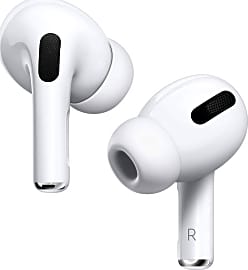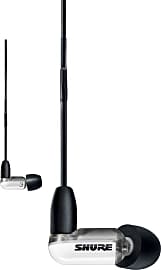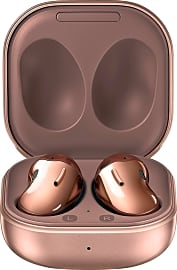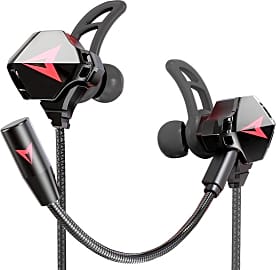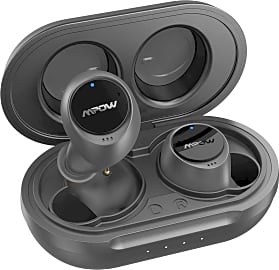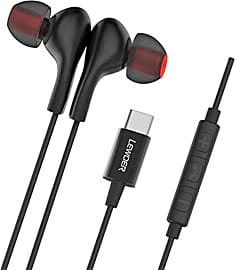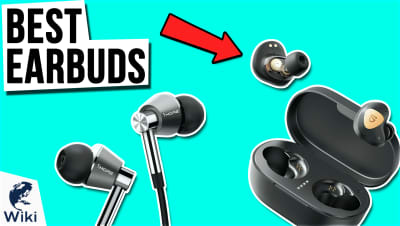The 10 Best Earbuds With Mics

This wiki has been updated 37 times since it was first published in April of 2016. It's easy to stay connected on the go when you've got a pair of earbuds with a built-in microphone. They not only provide a convenient way to listen to music or video content on your smartphone privately, but they also enable you to make and take phone calls without missing a beat. They're perfect for use while working, commuting, exercising and, in some cases, even gaming. When users buy our independently chosen editorial selections, we may earn commissions to help fund the Wiki.
Editor's Notes
December 07, 2020:
One of the most notable developments in the earbud market has been a shift towards the freedom of true wireless designs, as advances in technology offer ever-better performance in ever-more compact packages. Many of the best models for hands-free communication are now built along these lines, like our new #1 pick, the Jabra Elite 85t. The six-microphone array on each earpiece captures your speech as well as listening for outside sounds, so that the powerful noise cancellation technology can screen them out. The companion app lets you fine-tune the level of ambient noise that you want to allow through, and you can adjust your audio balance with its excellent equalizer function.
Our previous top picks, the Anker Soundcore Liberty Air 2, are still quality earbuds, but they can't match the performance of the Elite 85t, and they're outcompeted in the price department by the powerful but highly affordable Mpow X5. Meanwhile, the Apple Powerbeats Pro are a better pick for intense outdoor exercise, given their robust battery life and snug ear hooks, while for comfort it's hard to beat the Samsung Galaxy Buds Live, which feature an innovative design that locks them in place without anything protruding into the ear canal.
Of course, many customers will still prefer the reliability of neckband models. The Jabra Evolve 65E are fantastic for business applications, delivering crisp and professional sound on both ends of a call, while the Anker Soundcore Life U2 offer a hefty battery life and cVc 8.0 noise reduction for microphone clarity. For users who prefer to physically plug their earbuds into their phones, the Kasott Battle Buds are a decent low-cost pick, with the added benefit of a flexible and detachable microphone arm to let them act like a miniature headset. True audiophiles will be better served by the clarity and balance of the Shure Aonic 3.
If you're looking for something sturdier and you don't care as much about portability, then you might be interested in our list of the best headphones with mics. We can also recommend earbuds for those interested in particular features like powerful bass or top-shelf water resistance.
December 11, 2019:
When shopping for earbuds, and especially wireless earbuds, it can be remarkably difficult to find a pair that has a respectable built-in microphone. So we dug through a bevy of testing and design information to settle on some that sound good when spoken into. Don't be surprised by the inclusion of the classic Apple EarPods, as their timeless design and powerful components lend themselves very well to having phone conversations, especially if you're using an iPhone. For everyone else, the Betron YSM1000 cost about the same and look arguably better while performing well with Android devices. The wired Sony MDR-XB50AP and wireless Samsung U Flex are just a small step up in price and both provide impressive sound quality in a variety of music genres. On the other hand, the Insten In-Ear are among the least expensive options and the very few with a detachable mic boom.
If you want something that sounds particularly nice and should quite last a while, you might want to make a little more of an investment. It's hard to beat the Anker Soundcore Liberty Air 2 as far as mid-range to high-end true wireless ear buds go. The UC versions of the Jabra Evolve 65E cost about the same and are some of the best in-ear models for business use. And while the 1More Quad Driver aren't cheap, they do sound great, and deliver more lifelike audio than most others, likely because they're specifically designed to function as in-ear monitors for performers or sound engineers.
At the high end of earbud quality are the Apple AirPods and Bose QuietComfort 20. The AirPods are trendy for a reason; they're all-around high-performing ear speakers that generate very few complaints. And while the Bose don't have any wired capability, they do offer the excellent active noise cancellation for which the company has become known.
Who Benefits Most From Using Earbuds With Mics?
Headphones with built in microphones are a great example of technology being used to create multi-functioning tools which improve the overall quality of life.
As the modern era calls for the simplification of our complex lifestyles, devices that can perform multiple functions become ever more common. Consider the cell phone, which has evolved over the years from being a device used to simply make calls to the integral part of daily life it is now. The modern cell phone combines internet browser, game console, telephone, and thousands of apps into a computer the size of a hand.
While the change hasn't been as drastic in the world of headphones, the combination of earbuds with mics allows for many people to operate at a higher level of ease and efficiency than ever before.
In an office setting, earbuds with mics provide a hands-free way to communicate with coworkers or make business calls. Full headsets are often clunky and put pressure on the head. This may lead to an increase in tension headaches commonly experienced by office workers. The other option is to put calls on speakerphone, but this is much less private and will disturb the coworkers around the call. Earbuds with mics are a comfortable option for every business professional.
Using headphones with mics is a great way to increase safety while driving. A driver's ability to safely react to hazards on the road is greatly reduced when one of their hands is holding a phone. While not talking while driving may be the best option, earbuds with built in microphones are great for those calls that simply have to be made.
Of course, the utility of the earbuds themselves cannot be overlooked. Earbuds are much less bulky than headphones, and so often find their way into the gym or other exercise sessions. Earbuds are less likely to fall off the head while on a treadmill or elliptical, and are just as comfortable while lifting weights as they are while jogging. On a bicycle, earbuds are also more aerodynamic. They are also less likely than full headphones to fall off while riding at high speeds. Headphones with built in microphones are a great example of technology being used to create multi-functioning tools which improve the overall quality of life.
History Of Earbuds With Mics
On the surface, earbuds and mics are polar opposites. One is used to listen to audio, the other is intended to receive audio input. Yet the history of headphone speakers and mics are tied together in a few ways.
They were also favored by aircraft pilots in the armed forces.
The history behind headphones goes all the way back to the early 1900s. They were designed to allow one user the ability to listen to audio privately by placing small speakers on their head against their ears. An inventor named Nathaniel Baldwin is given credit for the invention of the first headphones, and his first customer was the U.S. Navy, just before World War I. Baldwin manufactured the headphones on his kitchen table and made history.
Since then, headphones have found their way into numerous industries and occupations. The first combination of headphones and microphone were the headsets made famous by switchboard operators. They were also favored by aircraft pilots in the armed forces. As the first headsets were bulky and required switchboard operators to exercise their necks in order to operate them, users quickly began to call for more lightweight versions.
The 1990s brought cell phones, and progress in the industry enabled headsets to become light enough for everyday use, allowing for hands-free use of telephones. Modern advancements brought Bluetooth technology to headsets, the invention of the earbud, and advances in ergonomic design to reduce the listener's fatigue.
How Do Earbuds with Mics Work?
In order to provide the increased functionality of earbuds with mics, there are a couple of elements manufacturers must factor in to their designs.
Both speakers and mics operate on electrical circuits. In a basic circuit, current flows from a power source to the device, and then from the device back to the power source. This is considered a complete circuit. If the device is switched off, the circuit cannot be completed, and the device will not function as intended. When the device is switched on, current flows from the device back to the power source, and the device begins to function.
If the device is switched off, the circuit cannot be completed, and the device will not function as intended.
In headphones, this electrical signal must be turned into a sound. To do this, speakers contain electromagnets and use a process called induction. Induction is how current itself is produced as it moves through a magnetic field. According to Faraday's law of induction, it is the interaction between a magnetic field and an electrical circuit which creates the current in the field. In a speaker, this current then oscillates a small diaphragm within the speaker itself. As this diaphragm oscillates, it translates these movements into sound waves, which reach our eardrums as the music, audiobooks, podcasts, and speeches that we know and love.
The microphones in earbuds with mics are another form of transducer. As one might think, the process works much in reverse. A microphone works to translate incoming audio waves into input that can be understood by electronic devices. In order to do this, the microphone relies on a similar diaphragm to the speaker. Diaphragms in microphones are very thin pieces of a material like paper, aluminum, or plastic, which are placed near the coil. When it is hit by sound waves, this diaphragm vibrates in turn. This vibration causes similar movements in the coil, which then converts the audio into an electrical signal to be sent through a cable and into whichever device it is plugged into.
In order to safely add the mic signal to the mix in earbuds with mics, changes in the the 3.5 mm jack are often made. At the input end of the headphone cable, most headphones contain 2 rings. The tip of the jack provides signal to the left ear, the first ring provides signal to the right ear, and the second ring is for electrical grounding. When the mic is included, a third ring must be added before the grounding ring to signal that the mic is attached. Combined, these factors make headphones with mics intricate yet simple wonders in the audio world.




